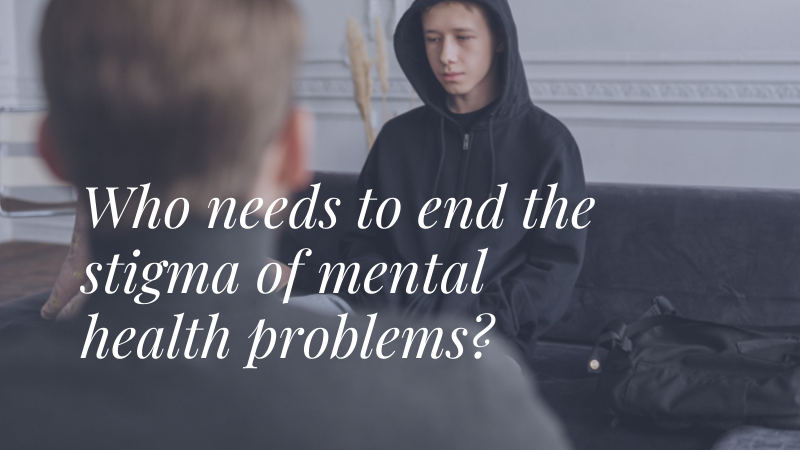I have recently published an article on mental health stigma and how people could change their view on mental health. However, what I recently realized is that is it not the people who need to change but the people who provide mental health services and the whole system.
I don’t think the system is working well or it doesn’t have the patient’s best interest in mind. The waiting lists for public services are incredibly long, not everybody can afford private therapy, different mental health professionals do not co-operate with each other. There is a lack of communication between services, there is a lack of statutory regulations. Yes, there are accreditation bodies but is that really enough? I personally do not think so.
What is History telling us?
Before we can ask people to change their perspective on mental health, we need to understand why there is a stigma in the first place and where it comes from? There is a stigma because people remember the past… because people are afraid… there is a stigma because there is a lot of trauma about mental health.
Talking about mental health stigma it is impossible to skip Irish history regarding the topic. In the 1800s and 1900s the time was terrific for people, over 20,000 people were instituted and being treated for mental health illnesses. The sheer number of people in the institutions meant that ill-treatment was rife, and their roots in the prison system meant that some patients were left chained up for months on end.
The Asylum…
The first major asylum – the Richmond Asylum, or Grangegorman – opened in 1814. But before this, people with mental illnesses were treated at home, often in quite shocking ways due to a lack of community or government support. People with mental illness could end up living quite difficult and short lives.
Within decades the asylums were too full, too big and grossly anti-therapeutic. What had started as a way to help people ended up damaging some of them.
The Dangerous Lunatic Act of 1838 also meant that someone could be committed to an asylum without medical opinion. It wasn’t necessary to have a medical certificate in order for magistrates to commit someone to an asylum. All that was needed was their opinion that someone was likely to commit an offense.
This led to families and communities beginning to use asylums in very specific ways, to remove mentally ill people or people with an intellectual disability or generally unwanted people from the family home.
However, we need to remember here that many of these families we are talking about, were poor, and were dealing with emigration and disease. Moreover, the State didn’t offer them any solution or support other than asylum.
We need to look at asylums as part of the much broader program of institutionalisation in Ireland, and that is including prisons, laundries and industrial schools. What happened with them has gone on to affect the psychiatric approach in Ireland today.
Mental Health Today
Looking back at the history of psychiatry in Ireland, you can clearly understand why there is such a tremendous trauma about mental health. Based on those facts, it is normal that people are afraid, or they don’t want to talk about mental health because they don’t know what to expect. When there is a mention of mental health there is already a feeling associated with that. There is a memory, that is still very much alive.
Even though mental health services have improved compared to the past, there is still something lacking. For me, as a psychotherapist, there is a lack of communication and cooperation between services. Psychiatry and psychotherapy are far away from each other. There is a lack of sympathy and it is very visible.
Psychiatry vs. Psychotherapy
Psychiatry will do assessments and prescribe medicines. There is no therapy, there is no hearing the client and make him feel understood. Nothing about psychiatry is about feelings and emotions. Facts are more appealing to psychiatry. And I understand that, I believe that there is room for this in a mental health service. It is needed too, when dealing with severe mental health illness… but not to the extent it is now.
Whereas psychotherapy will provide a place where people can talk through their issues. People will talk about their own truth. Psychotherapy is all about feelings, emotions, experience and wellbeing. A psychotherapist will not prescribe any medicines but will actively listen to the patient. Again, there is room for this type of treatment too.
So, what it would be like if rather than competing with themselves those two services would start working together? There are lots of benefits to it. Firstly, the mental health profession would be more consistent, and stronger. People wouldn’t need to wonder who is who, and where to seek help. They would see that they are looked after in the best possible way. This is about gaining people’s trust. People need to see that they can trust mental health services. All of this is about society, this is about people.
Mental Health service is not a competition of who is better? This is not about mental health practician’s ego. This is about finding a healthy balance between the services for society’s benefit!
Conclusion
After some unpleasant experiences, I am keen to believe that people who are working in psychiatry have a totally different view on helping people and they have completely different values when it comes to people and their issues. (Not all of them, I am sure there are nice psychiatrists somewhere too).
However, this is very disturbing to think that people in a similar area of expertise are so against each other. The goal should be the same… to provide the best service possible to people who need help. If someone doesn’t like people, or doesn’t like to deal with people’s issues they should never work in mental health services.
With love always


